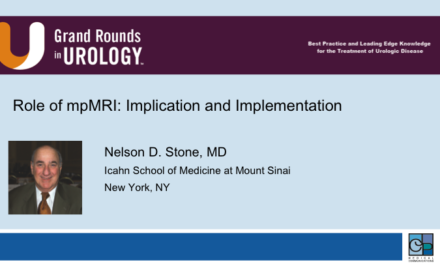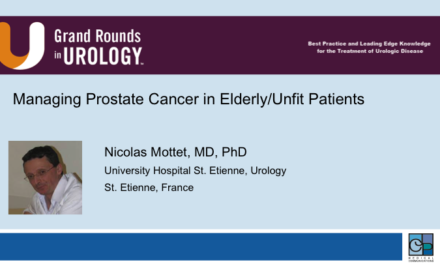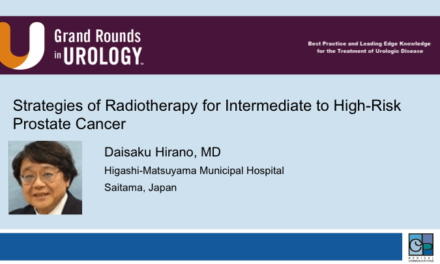Dr. James A. Eastham spoke at the 24th International Prostate Cancer Update on Friday, February 21, 2014 on “Robotic Salvage Prostatectomy.” In his presentation, Dr. Eastham discusses the advantages and challenges of using robotics for salvage radical prostatectomy.
Presentation
Keywords
salvage radical prostatectomy, biochemical, biopsy, bladder, recurrence, radiation, prostate, outcomes
How to cite: Eastham, James A. “Robotic Salvage Prostatectomy.” Grand Rounds in Urology. January 14, 2015. Accessed [datetotoday]. https://dev.grandroundsinurology.com/prostate-cancer-james-a-eastham-robotic-salvage-prostatectomy/.
Transcript
Robotic Salvage Prostatectomy
Good morning, everyone, and thanks again to Dr. Crawford for inviting me to participate in what’s always a great meeting. Can we start with my two questions, please? So while those are coming up there really are no direct randomized trials comparing any of the local therapies in a salvage setting, so my talk will focus really just on surgery. I’m not going to bash cryotherapy. There’s no reason to do that. Aaron can bash surgery if he wants, but that’s okay. So the first question is which of the following are true regarding robotic-assisted salvage radical prostatectomy—lower blood loss compared to conventional surgery, lower rates of incontinence, lower rates of positive margins, fewer bladder neck contractures, all of those are correct or only one and four are correct. Vote early and often.
So good. So yeah, choices one and four are correct, lower rates of blood loss and lower rates of bladder neck contractures. We can go to the next one. We can go to the next one. So which statement is correct—neoadjuvant androgen deprivation therapy for eight months improves biochemical recurrence-free survival after salvage radical prostatectomy compared to surgery alone, metastasis-free prostate cancer specific survival, overall survival, or none of the above are correct. Pretty easy.
Alright, interesting. So none of them are correct, actually, for salvage radical prostatectomy, so we’ll go through all that. Okay, let’s go to the talk then. So from the standpoint of definitions of biochemical failure after radiation therapy there are a variety that are out there. The most commonly used one is the Phoenix definition, which is nadir plus two. The important thing to remember about the Phoenix definition is that that predicts metastasis and death from prostate cancer. So if you have a patient that has been treated with radiation therapy and you wait for them to reach the nadir plus two definition, the chances that they have a local only recurrence that will be cured by salvage local therapy is very low. As you’ll see in most of the series that treat these types of patients, the median PSA value is in the four to eight range. So really we are identifying these patients too late. So nadir plus two predicts distant disease and death, not local recurrence. That’s the most important aspect of following these patients.
Now, if a local salvage therapy is going to work, you want to identify patients with local disease. Basically, it’s a negative metastatic workup and a PSA doubling time that’s not too short meaning three to six months, and you don’t want your PSA value to be too high. Most studies suggest that the lower the better just like with salvage radiation therapy. So waiting for these patients to declare themselves by reaching the Phoenix definition is really incorrect.
Now, one of the important things about treating radiation failures is that you do need to have a positive biopsy showing persistence of local disease. I get lots of patients that are sent to me for salvage treatment that basically have had a negative metastatic workup and a high PSA value. Those patients are not yet candidates for local therapy, so they need a biopsy of the prostate. Now, when one does a biopsy of the prostate you can get a report that comes back prostatic adenocarcinoma with severe radiation changes, which sounds incredibly ominous. It isn’t. If you treat these patients, you will have great outcomes because this is indolent disease. So while the prostatic adenocarcinoma is in the biopsy report these patients behave as if they have a negative biopsy. Several studies have shown this. I didn’t list them down here, but really at least in our center we only treat patients that have a Gleason gradable prostate cancer. Now, historically Gleason grades were not assigned to post-radiation biopsies, but as pathologists have become more comfortable looking at these post-treatment biopsies they’ll assign a Gleason score to them. We do not treat this entity which really has an indolent course.
So when one is evaluating a patient for salvage local therapy they certainly have to start with local disease at the prior to radiation therapy. So if a patient had a big T4 cancer had radiation therapy and lots of hormonal treatment and now is being considered for salvage local treatment, probably not the best candidate. Again, just like any surgical patient you want them to have good functional status and life expectancy and really free from many of the local side effects that fortunately are rarer with the newer modalities of radiation treatment.
So when one encounters such patients there is a variety of different options. Other than salvage HIFU we offer all of these at Memorial, and I’m sure most centers offer at least some combination of these. That’s because there is no best treatment that fits everyone. Now the topic of this is salvage radical prostatectomy and specifically robotic assisted treatment, so I’ll focus on that. Now, surgery in many ways appropriately has received a bad rap in the salvage setting. That’s because of doubts about its ability to cure radiation recurrent prostate cancer and also concerns and real concerns about side effects and morbidity of treatment. Now, if one looks at pathologic outcomes after salvage radical prostatectomy they’re fairly similar to non-radiated patients. The difficulty is we rarely find a patient who is organ-confined because most patients are evaluated too late. Again, relying on these ASTRO or Phoenix definitions for recurrence.
So if we look at—we had artificially—not so artificially but divided our first hundred salvage cases in 1992, which I’ll explain in a sec. But if you can find organ-confined disease the patients do very well. The problem is finding organ-confined disease. If one looks at longer term outcomes, this is about 150 patients we’ve treated with salvage radical prostatectomy—about half of the patients with salvage surgery alone remained free from biochemical recurrence. So as a salvage treatment a relatively good treatment option in that half of the patients at least for five years will remain free of disease.
Prostate cancer specific survival is pretty good. Twenty percent of the patients have died of prostate cancer at ten years, but 80% of the patients have either died of something else or are still alive. So, again, suggesting that these outcomes are actually not bad in terms of the oncologic setting. In terms of local recurrence, in our series—this was about 125 patients—we only had one patient that had a symptomatic local recurrence that required treatment—a gentleman that required a TUR for obstruction. We didn’t have anybody that required a stent or a – – because of locally progressive disease. Some did because of retroperitoneal adenopathy but none because of local failure. So as a local treatment to prevent local issues salvage radical prostatectomy appears to do a very good job.
Now, this is a multi-center compilation of data. We’re one of the centers in this and contributed about a quarter of the patients, but about 400 patients—again, median PSA about 4.5, standard definitions for biochemical failure. Basically, at ten years the biochemical-free survival was about 37%—so a little less than what we had seen in our series. Again, metastasis-free and prostate cancer specific survival of about 80%. So as a clinical endpoint rather than just a biochemical endpoint salvage surgery seems to be doing a very good job. Now, if we look at just multiple reports, the outcomes vary tremendously. Biochemical-free rates—again, it depends on follow-up and cancer specific survival, again, show that biochemical recurrence rates are high but cancer specific survival is relatively good.
So I think what we can say about oncologic outcomes is that the long-term progression-free survival by pathologic stage is fairly good—anyway, cancer specific and metastasis-free survival are excellent as is overall survival for these patients. So if we look at now outcomes in terms of complications, you know, salvage radical prostatectomy historically and not so historically was fraught with intraoperative injuries in terms of ureteral injuries, rectal injuries, etc. Historically, that was, we think, because many of these patients had undergone prior open surgery.
So they had undergone either an open pelvic lymph node dissection and/or an open seed implant. So 1992/93 was about the dividing time between those patients who had received prior open surgery, which again made the operation much more difficult, and then 93 where most of the patients were now undergoing transperineal implants. Our external beam radiation techniques improved as well.
So what one sees is that in the more contemporary series, which isn’t so contemporary anymore, that complication rates basically rivaled what we were seeing with standard open radical prostatectomy. So length of stay declined. Readmission rate was about the same even with a shorter length of stay, and the patients who can undergo just a standard radical prostatectomy were similar. The number of rectal injuries or the percentage of rectal injuries declined, as did the number of ureteral injuries. The obturator nerve injuries we did less pelvic lymph node dissections in the much earlier series because most of the patients had already undergone a prior node dissection and that area was just not addressed.
The one area that has not improved over time—and these are all open salvage radical prostatectomies—is the development of an anastomotic stricture or bladder neck contracture. That still plagues us today in the open setting. About 25 to 30% of the patients will develop a bladder neck contracture, and these are difficult to treat. These are not simply a dilation. These are patients that typically have to have that scar tissue resected, and many will go on intermittent catheterization and require several surgical procedures. So despite improvements in radiation therapy, better targeting, and better surgical technique we still have problems with anastomotic strictures.
From the standpoint of continence it has improved over time but it’s still an issue following this type of procedure. I tell patients there’s about a 50% chance you’ll be pad-free, about a 25% chance you’ll be wearing pads but probably do okay with that, and about a 25% chance you’re going to need a sphincter. I think that’s what most series will show, but incontinence and bladder neck contractures are the continued plague of this procedure. As I mentioned previously several times, the PSA at the time of treatment is a predictor of outcome. The lower the better. This was just under four does better than any other PSA. If you can find patients with lower Gleason score on their post-radiation biopsies, those patients tend to do better. They’re the less common patients, but if you can find them early they do tend to do better.
Oh, this is my old talk. Sorry about that. So this is—I said I wasn’t going to compare cryotherapy, but this is Lou Pisters. This is the Mayo Clinic and MD Anderson Hospital comparing salvage cryotherapy with salvage radical prostatectomy. It’s not a great comparison, but about the only thing—I’ll just flip to the conclusions—is that they suggested that younger patients—and this is what we do at Memorial. Younger patients with longer life expectancies probably should be considered more for salvage radical prostatectomy than salvage cryotherapy, although that is in a state of flux. Older patients that have a reasonable but not ten or 15 year life expectancy would do better with a local ablative therapy.
So in conclusion from that paper they suggested that the oncologic outcomes after salvage radical prostatectomy were “better” than the temperature-based therapies—cryotherapy included. Incontinence rates and bladder neck contractures were higher after salvage radical prostatectomy. Salvage brachytherapy is something we’re doing at our center, but I don’t think there’s any long-term outcomes that we can discuss. So let me go through this. If one looks specifically at minimally invasive surgery—so much of these were laparoscopic series. Some of them were robotic series. Very small numbers of patients. But if one looks at the rectal injury rate and the high grade complications, Clavien three through five, they were similar between the reports. The one big difference was there were lower rates of bladder neck contractures in those patients undergoing minimally invasive surgery. If you look at continence rates, they vary substantially, but about 20 to 83% versus zero to 80%. So I don’t think you can say that unfortunately continence has not been improved with these minimally invasive technologies despite the lower bladder neck contracture rates, which I found a bit surprising.
So in summary what I think we can say is that if we’re going to use salvage local therapies it’s best to find the patients earlier in their course of recurrence. Don’t wait until the Phoenix definition of recurrence if you’re going to evaluate a patient for local therapies. I think salvage radical prostatectomy is a technically demanding operation however it’s done whether it’s done through an open or a minimally invasive approach while the robotic technique is certainly feasible and we’ve done it and it does result in lower blood loss and lower rates of bladder neck contracture there are still the issues with incontinence. There is no improvement in oncologic outcomes at least short-term in terms of biochemical recurrence. The other salvage therapies I’ll leave to Dr. Katz. Thank you very much.
References
Bianco FJ Jr, Scardino PT, Stephenson AJ, et al. Long-term oncologic results of salvage radical prostatectomy for locally recurrent prostate cancer after radiotherapy. Int J Radiat Oncol Biol Phys. 2005 Jun 1;62(2):448-53. http://www.ncbi.nlm.nih.gov/pubmed/15890586
Chade DC, Eastham J, Graefen M, et al. Cancer control and functional outcomes of salvage radical prostatectomy for radiation-recurrent prostate cancer: a systematic review of the literature. Eur Urol. 2012 May;61(5):961-71. http://www.ncbi.nlm.nih.gov/pubmed/22280856
Paparel P, Cronin AM, Savage C, et al. Oncologic outcome and patterns of recurrence after salvage radical prostatectomy. Eur Urol. 2009 Feb;55(2):404-10. http://www.ncbi.nlm.nih.gov/pubmed/18639970
Pisters LL, Leibovici D, Blute M, et al. Locally recurrent prostate cancer after initial radiation therapy: a comparison of salvage radical prostatectomy versus cryotherapy. J Urol. 2009 Aug;182(2):517-25; discussion 525-7. http://www.ncbi.nlm.nih.gov/pubmed/19524984
Stephenson AJ, Scardino PT, Bianco FJ Jr, et al. Morbidity and functional outcomes of salvage radical prostatectomy for locally recurrent prostate cancer after radiation therapy. J Urol. 2004 Dec;172(6 Pt 1):2239-43. http://www.ncbi.nlm.nih.gov/pubmed/15538239
ABOUT THE AUTHOR
James A. Eastham, MD, FACS, is the Peter T. Scardino Chair in Oncology and Chief of the Urology Service in the Department of Surgery at Memorial Sloan-Kettering Cancer Center in New York. Dr. Eastham received his medical degree from the University of Southern California, Los Angeles. He completed an Internship in General Surgery and a Residency in Urology at Los Angeles County+USC Medical Center. He went on to complete a Fellowship in Urologic Oncology at Baylor College of Medicine in Houston, Texas. Prior to his appointment at Memorial Sloan-Kettering Cancer Center, Dr. Eastham was an Assistant and Associate Professor in the Department of Urology at Louisiana State University in Shreveport and Chief of Urology at Overton-Brooks Veterans Administration Medical Center in Louisiana.
Dr. Eastham’s research has focused on the prevention and treatment of prostate cancer, and he has a particular interest in improving oncologic and quality-of-life outcomes after radical prostatectomy. He has authored or co-authored over 300 articles which have appeared in peer-reviewed journals such as the Journal of the American Medical Association, the Journal of Urology, the Journal of Clinical Oncology, Urology, and Transplantation. In addition, he has authored numerous book chapters, reviews, monographs, and abstracts. He is a Fellow of the American College of Surgeons and a member of several professional societies, including the American Urologic Association, the Society of Urologic Oncology, and the Societé Internationale D’Urologie.





